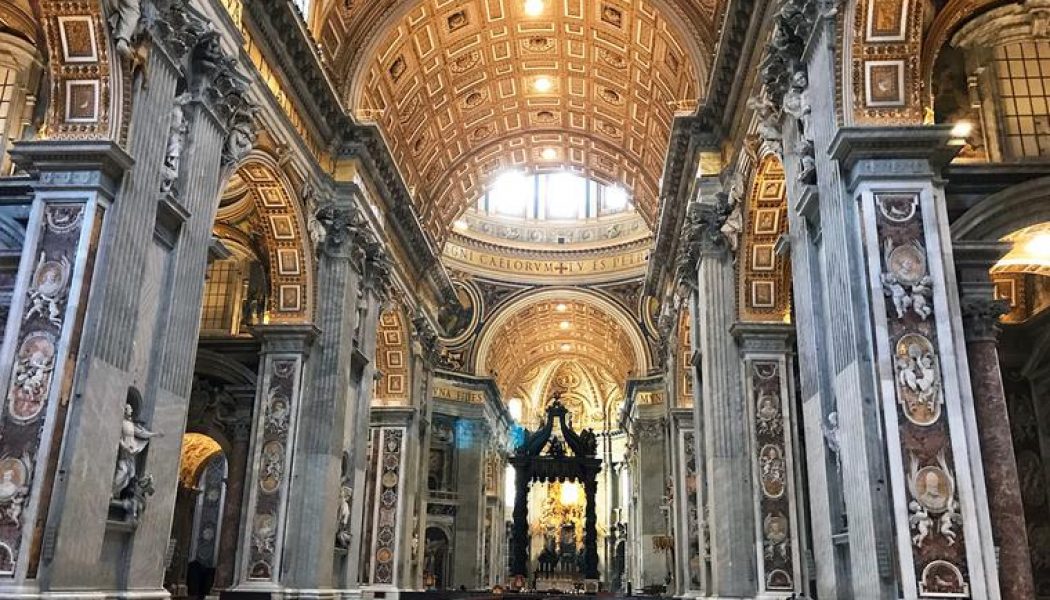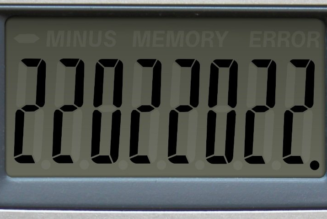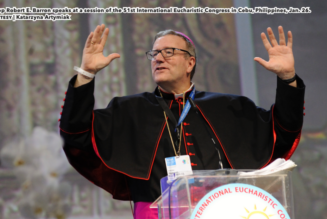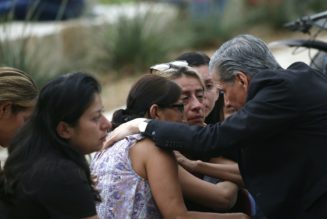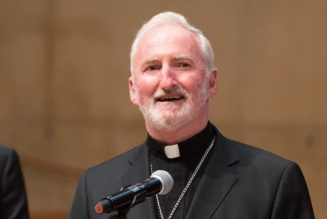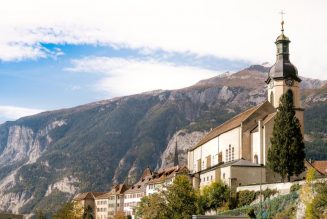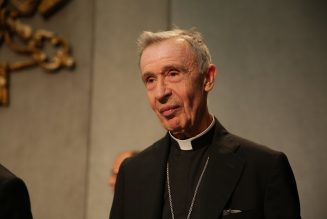
VATICAN CITY — Cardinal Raymond Burke has expressed his “deepest concerns” about an internal Vatican letter regarding new rules for Masses celebrated in St. Peter’s basilica, saying it is in “direct violation of universal Church law” and should be “rescinded immediately.”
The five-point letter addressed to the administrators of the basilica from the Secretariat of State states that “individual celebrations are suppressed” at the side altars of St. Peter’s, and that priests and faithful coming to the basilica or Mass will only be able to take part in one of four concelebrated Masses each morning, as well as other concelebrated Masses during the day at the main altars.
The Vatican instruction, which is dated March 12 and comes into effect March 22, says that these concelebrations should have the assistance of readers and cantors, and that groups of pilgrims accompanied by a bishop or priest are now to celebrate Mass in the Vatican grottoes underneath the basilica.
Its last point states that “authorized priests” who wish to celebrate Masses in the extraordinary form, or traditional Latin Mass, can do so only in the Clementine Chapel of the grottoes, and at four set times each morning, also limited to 30 minutes.
The letter’s introduction states that being the season of Lent, which gives “greater centrality to listening to the Word of God and to the Eucharistic Celebration,” it is important for Masses to take place “in an atmosphere of recollection and liturgical decorum.”
Until now, priests have been able to celebrate individual Masses, including in the Extraordinary Form of the Roman Rite, every morning in the basilica’s many side altars. Often the priests are Vatican officials celebrating morning Mass before their workday begins, and altars were free to be booked whenever a priest wished to celebrate Mass at them.
“It was all very free and thus encouraging attendance both of priests and faithful of all types and leanings or sensibilities,” said a priest speaking on anonymity who has individually celebrated Masses in the basilica.
The contents of the March 12 letter, which carries no clear signature but the initials of the sostituto (deputy) of the Secretariat of State, Archbishop Edgar Peña Parra, were not formally announced, nor does it have a protocol number usual for legislating the most sacred aspects of the Church’s life. According to Cardinal Burke, these deficiencies mean the document cannot represent “valid legislation for the Sacred Liturgy.”
Other anomalies include the fact that the letter came from the Secretariat of State, which is not competent for the liturgical discipline of the Church, nor was it communicated to the cardinal archpriest of the basilica but rather the extraordinary commissioner for the Fabric of St. Peter, which does not deal with liturgies in the basilica but rather its administration and maintenance.
These questions regarding the document, which have yet to be clarified by the Holy See Press Office, have led some to suspect the document is a forgery. However, sources in the Vatican Secretariat of State have confirmed its authenticity to the Register.
The Register contacted the Holy See Press Office for comment on the letter, but it has not yet responded, as the Vatican offices were closed Saturday to mark the eight anniversary of Pope Francis’ election.
For Cardinal Burke and other canonists and priests contacted by the Register, the most serious element of the letter concerns its imposition of concelebration upon priests who wish to offer Mass in the basilica — a change, they say, that pertains not only to the basilica but the universal Church, as St. Peter’s is the spiritual home for all Catholics and, they say, should be a model of liturgical discipline.
The letter, Cardinal Burke wrote in a statement to be published on his website, is “contrary to universal Church law” as it “unjustly conditions the primary duty of the individual priest to offer the Holy Mass daily for the salvation of the world.” More specifically, he and other canonists say it is in breach of both Canon 902 and Article 57 § 2 of Sacrosanctum Concilium.
“In what church more than in the Basilica of Saint Peter would a priest desire to offer the Holy Mass, which is the most perfect and fullest way in which he carries out his priestly mission?” the former prefect of the Apostolic Signatura asked. “If an individual priest wishes to offer the Holy Mass in the basilica, once the directives in question are in force, he will be constrained to concelebrate, in violation of his freedom to offer the Holy Mass individually.” Cardinal Burke added that for a priest to individually offer Mass is not only a right but brings “great spiritual fruit for the whole Church.”
Regarding its rules on celebrating Mass in the Extraordinary Form of the Roman Rite (which he notes the letter “falsely calls the Extraordinary Rite”), Cardinal Burke stressed that according to the Pope Benedict XVI’s 2007 motu proprio Summorum Pontificum no priest in good standing needs authorization to celebrate Mass in the Extraordinary Form.
He also wondered if, according to the letter, the basilica is restricting such Masses to only four priests each day, a provision that, if true, would be another “direct violation of universal Church law.”
Restricting Mass in the Extraordinary Form to the Vatican grottos is also a return to previous practice that existed before Summorum Pontificum.
Further criticisms the cardinal makes about the letter is its requirement that the concelebrated Masses be “liturgically animated” by lectors and cantors.
Cardinal Burke said while liturgical discipline provides for their service, it is “not their purpose to animate the Sacred Liturgy,” but rather it is “Christ alone, in whose person the priest acts,” who “animates the Sacred Liturgy.”
Given all of these reasons, he said that letter “should be rescinded immediately,” that the “thinking which underlies such a document should be corrected,” and that the underlying liturgical doctrine and discipline of the universal Church be “expounded for the faithful.”
Cardinal Burke also takes issue with the letter’s introduction, which says that the new rules are intended so that Masses in the basilica are celebrated in an “atmosphere of recollection and liturgical decorum.” This presupposes that this currently is lacking in some way, but he said this was certainly not the case “in his experience,” nor in the experience of many priests he knows in Rome and abroad who have celebrated or regularly celebrate Mass in the basilica.
The cardinal ended his statement by referring to Canon 212, which recognizes the right for the faithful to make their concerns known to their pastors for the good of the Church, and calling on the faithful, for whom the basilica is their “mother church,” and priests throughout the world, “to make known to Pope Francis and to his Secretariat of State their strong objection to the document in question.”
Some have wondered if COVID-19 is part of the reason for this proposed change, but it isn’t mentioned in the letter. Concelebrated Masses were also temporarily banned during last year’s lockdown to help prevent contagion.
However, Church sources have told the Register that this is a change some in the Vatican have been pushing for many years, going back to when Cardinal Virgilio Noè was archpriest of the basilica from 1991 to 2002.
CNA’s Andrea Gagliarducci also reported in January that a “broad discussion” among members of the Chapter of the Basilica had been taking place over whether to keep the possibility for priests and pilgrims to book individual Masses or rule that they must take part in those already scheduled. These decisions were postponed until the Feb. 20 retirement of Cardinal Angelo Comastri as archpriest, and his subsequent replacement by Cardinal Mauro Gambetti.
Gagliarducci also reported that abolishing daily Mass in Latin in the Ordinary Form of the Roman Rite in the basilica was part of the discussions but there is no mention of that in the letter.
Join Our Telegram Group : Salvation & Prosperity
